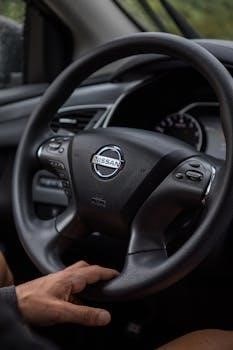Article Plan⁚ Nissan Malfunction ⎼ See Owner’s Manual
This guide addresses the “Nissan Malfunction See Owner’s Manual” message. We’ll explore common Nissan issues like CVT transmission failures, engine problems (misfires, noises), oil leaks affecting models such as Altima, Frontier, and rusting issues, especially concerning Navara trucks.
Encountering the ominous “Nissan Malfunction See Owner’s Manual” message on your dashboard can be unsettling. This alert indicates that your vehicle’s onboard diagnostic system has detected an issue requiring attention. It’s crucial to understand that this message isn’t a specific diagnosis but rather a general warning, signaling the need for further investigation.
This guide aims to demystify this alert by providing a comprehensive overview of potential problems that can trigger it. We will delve into common Nissan issues, including CVT transmission problems, engine malfunctions, oil leaks, rusting concerns, sunroof issues, and electrical system glitches.
By understanding the potential causes behind this message, you’ll be better equipped to troubleshoot the problem, communicate effectively with mechanics, and make informed decisions about repairs. Ignoring this warning could lead to further damage and costly repairs. This guide serves as a starting point for understanding the complexities of Nissan vehicle maintenance and troubleshooting.

Furthermore, we will emphasize the importance of consulting your owner’s manual, as it contains specific information about your vehicle’s systems and recommended maintenance procedures. This resource, combined with the information provided here, will enable you to address the “Nissan Malfunction See Owner’s Manual” alert effectively.
Common Nissan Problems Overview
Nissan vehicles, while generally reliable, are susceptible to certain recurring issues. Understanding these common problems can help owners proactively address potential concerns and mitigate costly repairs. Among the most frequently reported issues are related to the continuously variable transmission (CVT), particularly in models from the early to mid-2010s. These CVT issues often manifest as jerking, shaking, or a loss of acceleration.
Engine-related problems are another common concern, encompassing misfires, unusual noises, and stalling. Oil leaks, affecting models like the Altima, Frontier, Rogue, and Versa, are also frequently reported. Rusting, especially on the underbody and in models like the Navara, poses a significant threat to structural integrity.
Sunroof shattering is another alarming issue, affecting various models across different years. Electrical system problems, such as backup camera malfunctions, can also occur. These issues, alongside model-specific concerns like airbag and brake problems in the Frontier, highlight the importance of regular maintenance and prompt attention to warning signs.
By familiarizing yourself with these common Nissan problems, you can better anticipate potential issues, perform routine checks, and seek professional assistance when necessary, ultimately extending the life and reliability of your vehicle.
CVT Transmission Issues⁚ A Frequent Concern
One of the most prevalent issues plaguing Nissan vehicles, particularly those manufactured in the early to mid-2010s, is related to their Continuously Variable Transmissions (CVTs). These transmissions, designed for fuel efficiency and smooth operation, have unfortunately been a source of significant problems for many Nissan owners.
Common symptoms of CVT trouble include a noticeable jerking or shaking sensation during acceleration, hesitation or sluggishness when attempting to accelerate, and unusual noises emanating from the transmission. In more severe cases, drivers may experience a complete loss of acceleration or even total transmission failure, rendering the vehicle undrivable.
Certain models, such as the Sentra and Altima, have been particularly prone to CVT problems. The 2014 Sentra, for instance, has received numerous complaints regarding transmission failure. These failures often necessitate costly repairs or even complete transmission replacements, placing a significant financial burden on owners.
While Nissan has made efforts to improve the reliability of their CVTs in more recent models, the legacy of these transmission issues continues to be a concern for potential buyers and current owners alike. Regular maintenance, including fluid changes, may help to prolong the life of the CVT, but vigilance and prompt attention to any warning signs are crucial for avoiding major problems.
Engine Problems⁚ Misfires, Noises, and Stalling
Beyond transmission woes, Nissan vehicles are also susceptible to various engine-related problems, contributing to the dreaded “See Owner’s Manual” message. These issues range from relatively minor inconveniences to more serious malfunctions that can significantly impact vehicle performance and reliability.
One common complaint is engine misfires, which occur when one or more cylinders fail to ignite the air-fuel mixture properly. This can result in rough idling, decreased power, and poor fuel economy. Unusual noises, such as knocking or rattling sounds emanating from the engine, are also frequently reported, often indicating underlying mechanical problems.
In more severe cases, Nissan owners may experience engine stalling, where the engine unexpectedly shuts off while driving or idling. This can be a dangerous situation, particularly if it occurs in heavy traffic or at high speeds. Difficulty starting the engine is another related issue, often stemming from problems with the fuel system, ignition system, or battery.
Several factors can contribute to these engine problems, including faulty spark plugs, worn-out ignition coils, fuel injector issues, and problems with the engine’s timing chain assembly. Regular maintenance, such as oil changes and tune-ups, can help to prevent some of these issues, but prompt diagnosis and repair are crucial for addressing any engine-related symptoms that arise.
Oil Leaks⁚ Causes and Affected Models
Oil leaks are a frequently reported issue among Nissan vehicles, triggering the “See Owner’s Manual” message. These leaks can range from minor seepage to significant drips, potentially leading to engine damage and costly repairs. The problem is alarmingly common, particularly in older models, though newer vehicles are not entirely immune.
Several factors contribute to oil leaks in Nissans. Degraded engine gaskets are a primary culprit, as these seals become brittle and lose their ability to contain oil over time. Leaks can also originate from the oil pan, especially if it has been damaged or improperly sealed. Bad connections and fittings, along with a broken or loose filler cap, can also contribute to oil loss.
Certain Nissan models appear to be more susceptible to oil leaks than others. The Nissan Frontier, Rogue, Versa, and Altima are frequently mentioned in owner reports and recall notices. Nissan has even recalled thousands of vehicles due to oil leaks traced back to substandard bolting during production.
Addressing oil leaks promptly is crucial to prevent further engine damage. The cost of repair can vary widely, ranging from $100 to $2,000 depending on the severity and location of the leak. Regular inspection and maintenance, including checking for oil spots under the vehicle, can help detect leaks early on and prevent them from escalating into more serious problems.
Rusting Issues⁚ Body and Underbody Concerns
Rust poses a significant threat to Nissan vehicles, particularly affecting the body and underbody. This is a critical concern that can trigger the “See Owner’s Manual” message. Rust can compromise structural integrity and lead to costly repairs, affecting various Nissan models. The issue ranges from surface blemishes to severe corrosion.
The Nissan Navara truck has faced severe criticism for rust-related problems. In extreme cases, rust can weaken the connection between the cabin and cargo area, potentially leading to separation. However, the Navara isn’t the only culprit; models like the Altima and Xterra also exhibit rust issues. Coastal regions and areas with heavy road salt usage exacerbate the problem.
Regular inspections are crucial to detect and address rust early. Focus on the underbody, wheel wells, and areas prone to moisture accumulation. Addressing minor rust promptly prevents it from spreading and causing extensive damage. While interior rust is less common, it’s still important to check for signs of corrosion inside the vehicle.
Environmental factors play a significant role in rust development. Exposure to salt, moisture, and harsh weather conditions accelerates corrosion. Proper maintenance, including regular washing and waxing, helps protect the vehicle’s paint and underbody from rust. Applying rust inhibitors and protective coatings further safeguards against corrosion.

Sunroof Problems⁚ Shattering Risks
Certain Nissan models are susceptible to sunroof shattering, presenting a safety risk. This issue can trigger the “See Owner’s Manual” message, prompting drivers to seek immediate inspection. The problem affects models like the Maxima, Pathfinder, Rogue, Murano, Infiniti JX35, and QX60, spanning model years from 2009 to 2020, indicating persistent sunroof quality issues. Sunroof shattering poses injury risks to vehicle occupants.
Exploding sunroofs can disorient drivers, potentially leading to accidents. External factors like extreme weather and debris contact are often cited as causes, but many drivers believe shattering occurs randomly due to substandard engineering. There are accusations of using tempered glass instead of laminated glass.
Laminated glass holds together when shattered, unlike tempered glass, which explodes into small pieces. While external factors contribute, the consistency of sunroof failures across different models suggests underlying design flaws. The issue highlights the importance of sunroof maintenance and inspection.
It is important to check for cracks, chips, and other damage regularly. Drivers experiencing sunroof problems should consult a qualified technician for repair or replacement. Addressing sunroof issues promptly mitigates safety risks and prevents further damage. Consider aftermarket sunroof protection films for increased safety and durability. This will help prevent spontaneous shattering.
Electrical System Issues⁚ Backup Camera Malfunctions
Electrical system glitches, particularly backup camera malfunctions, are a notable concern in some Nissan models. This issue may trigger the “See Owner’s Manual” message, indicating a problem requiring attention. Nissan has recalled over a million vehicles due to backup camera problems, highlighting the significance of this issue. A software error in affected cars allows drivers to adjust camera settings in a way that prevents the image from displaying.
This violates federal safety standards, mandating a functional backup camera system. The Altima and Frontier are examples of models experiencing these backup camera issues. The primary safety concern stems from the system’s inability to display images, compromising rear visibility. This compromises driver awareness when reversing, increasing the risk of accidents.
The problem may range from a simple software glitch to hardware failure, each requiring specific diagnostic procedures. Owners experiencing backup camera issues should schedule a diagnostic check with a qualified technician.
Ensure the camera lens is clean and free from obstructions. Check the vehicle’s settings to confirm the backup camera system is enabled. If problems persist, the system needs professional attention. Regularly updating the vehicle’s software may resolve software-related glitches. Consulting the owner’s manual provides additional troubleshooting steps and system information. Addressing backup camera malfunctions promptly is essential for maintaining vehicle safety and complying with regulations.
Model-Specific Problems (Altima, Frontier)
Certain Nissan models exhibit unique problems that can trigger the “See Owner’s Manual” message. For the Altima, a common issue is the infotainment system’s volume knob malfunctioning, causing erratic volume adjustments. The average annual repair cost for an Altima is around $485.
The Nissan Frontier is prone to radiator ruptures and issues with the fuel sending unit. Specifically, the 2012 Frontier may develop problems with faulty airbags, unreliable brakes, and engine failures. These issues contribute to the overall ownership experience and should be considered when evaluating these models. These model-specific problems highlight the importance of understanding the common issues associated with particular vehicles.
Reviewing owner complaints and technical service bulletins can help identify potential problems. Regular maintenance and addressing issues promptly can help mitigate the impact of model-specific problems. Consulting with qualified technicians familiar with these models can ensure accurate diagnosis and repair. The owner’s manual provides valuable information about specific systems and components, aiding in troubleshooting and maintenance.
Understanding these model-specific issues is crucial for making informed decisions about purchasing and maintaining these Nissan vehicles. Proactive maintenance and timely repairs can help extend the lifespan and reliability of these vehicles, ultimately enhancing the ownership experience.

Interpreting the “See Owner’s Manual” Message

The “See Owner’s Manual” message in your Nissan indicates a detected malfunction requiring immediate attention. It’s crucial to consult your vehicle’s owner’s manual to understand the specific issue and recommended actions. This message is a general alert, signaling a problem within one of the vehicle’s many systems, ranging from the engine and transmission to the electrical system and safety features.
The owner’s manual provides detailed information about potential causes and troubleshooting steps. It may direct you to check specific components or systems, such as fluid levels, sensors, or wiring connections. The manual also outlines the severity of the issue and whether it’s safe to continue driving the vehicle. Ignoring this message can lead to further damage or compromise safety.
If the owner’s manual doesn’t provide a clear explanation or solution, it’s essential to seek professional assistance from a qualified mechanic. A diagnostic scan can pinpoint the exact source of the malfunction. Remember, the “See Owner’s Manual” message is a prompt to investigate and address the underlying issue to maintain your Nissan’s reliability and safety.
The message could relate to anything from a minor sensor issue to a serious mechanical problem. Prioritize consulting the manual, as it’s the first step in understanding the situation and determining the appropriate course of action. This ensures you’re informed and can make the best decision for your vehicle’s health.